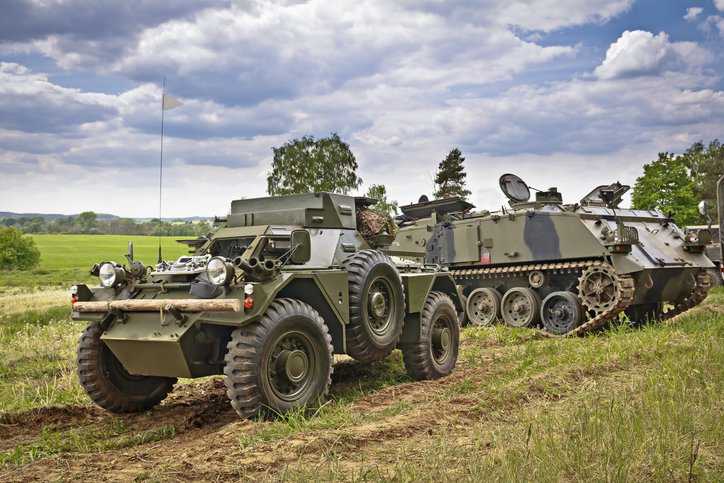A key issue for military equipment constructors is ensuring the stability and mobility of military vehicles during combat, as tires get especially damaged by vehicle-targeted fire. Runflat tires enable military vehicles to withstand high loads and stresses of treacherous terrain. SAE J 2014-2022: Pneumatic Tire/Wheel/Runflat Assembly Qualifications For Military Tactical Wheeled Vehicles was developed as a guide to all branches of the Department of Defense to evaluate tire/wheel/runflat systems and related vehicle performance.
What Are Pneumatic Tires?
A pneumatic tire is a rubber tire filled with air under pressure and mounted around the wheel of a vehicle. The outer part of the pneumatic tire is made of flexible, hollow rubber which is inflated by air pressure. Pneumatic tires are ideal to use outdoors because of their ability to absorb the unevenness of terrain. This allows for a smoother ride and overall less bumping and shaking. Pneumatic tires also have a thicker tread, providing traction on wet, icy, and uneven terrain.
What Tires Do Military Vehicles Use?
Army vehicles have pneumatic tires, also known as runflat tires. Runflat tires have reinforced sidewalls that prevent blowout, meaning they will not need air to stay stiff. These tires also can operate without air pressure for an extended period of time, which can enable the vehicle to steer toward a safe area. Sidewalls are not designed to be permanent as extra driving only is recommended for approximately 80 km (49.7 miles) after the deflated tire. Since military vehicles are operated in extreme conditions and often carry high payloads, runflat tires are essential in assuring that these vehicles are reliable and safe. Standards like SAE J 2014-2022 help ensure that manufacturers and constructors produce quality tires for military tactile wheeled vehicles.
What Is SAE J 2014-2022?
SAE J 2014-2022 applies to all combinations of pneumatic tires, wheels, or runflat for military tactical wheeled vehicles. It applies to original equipment and new replacement tires, retread tires, wheels, or runflat devices. SAE J 2014-2022 describes tests and test methodology, which will be used to evaluate and measure tire/wheel/runflat system and changes in vehicle performance. All tests included in this standard are not required for each tire/wheel/runflat assembly.
Military Inventions that We Use Every Day
Some of the most impactful innovations in the world have originated from military applications.
- The Internet: Created by scientists working for the US Department of Defense, the purpose of the ARPANET (the first public packet switched computer network) was to link universities, government agencies, and defense contractors throughout the United States, enabling exchange of information and shared computing power. In the Cold War, the ARPANET was important to build an information-sharing and computational system without a central command hub. The name “Internet” comes from this spread-out structure: groups of interlinked computers (networks) were connected together to form larger clusters (internetworks).
- GPS Satellite Navigation: In 1978, the Department launched the first satellite in its Navigation System with Timing and Ranging (NAVSTAR). The system, developed by the US military, became fully operational in 1993, with 24 satellites orbiting the Earth at approximately 19,300 km up. In 1983, the US government decided to make GPS freely available to the whole world.
- Microwaveable Ovens: In 1946, a scientist named Percy Spencer was working on a magnetron (a device that produces the vibrating electromagnetic waves that make radar possible) to increase the power levels that could be used in radar sets. Spencer concentrated the magnetron’s electromagnetic waves on a raw egg and some kernels of corn and made the first-ever microwave popcorn. The first model of the commercial microwave oven, called a “Randarange,” was released on the market in 1947.
- Duct Tape: During WWII, the standard practice for packing artillery shells was to seal a box with paper tape, with a little bit of tape left as a tab at the end that troops could pull to open the box, and then dip the whole thing in wax to make it waterproof. Vesta Stoudt proposed that they replace the wax and paper tape with a new type of water-resistant, cloth-based tape instead. It was also called “duck tape” because it was made from cotton duck cloth (a type of canvas fabric) and because of its water-resistant properties. Duck tape eventually became “duct tape” when it was introduced into the civilian market, and it changed from its original army green color to a silvery grey.
SAE J 2014-2022: Pneumatic Tire/Wheel/Runflat Assembly Qualifications For Military Tactical Wheeled Vehicles is available on the ANSI Webstore.
